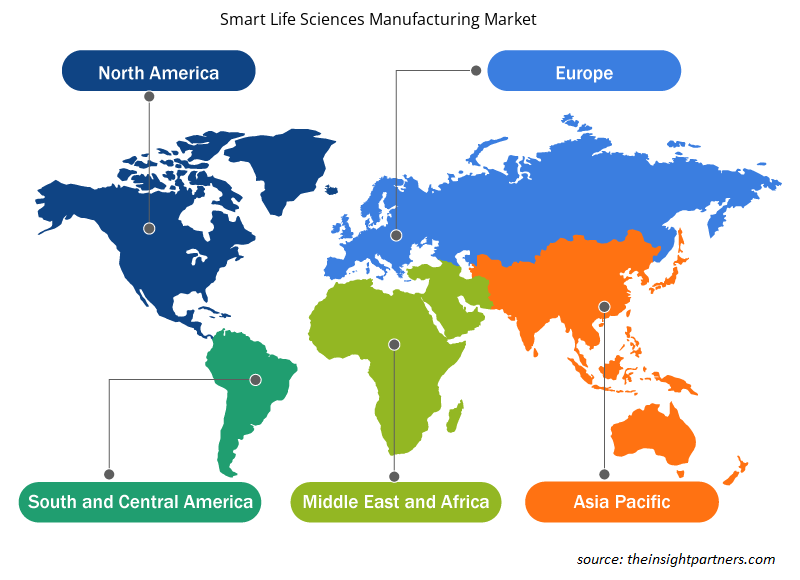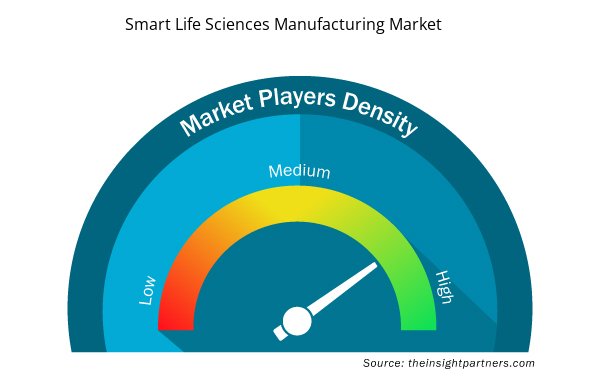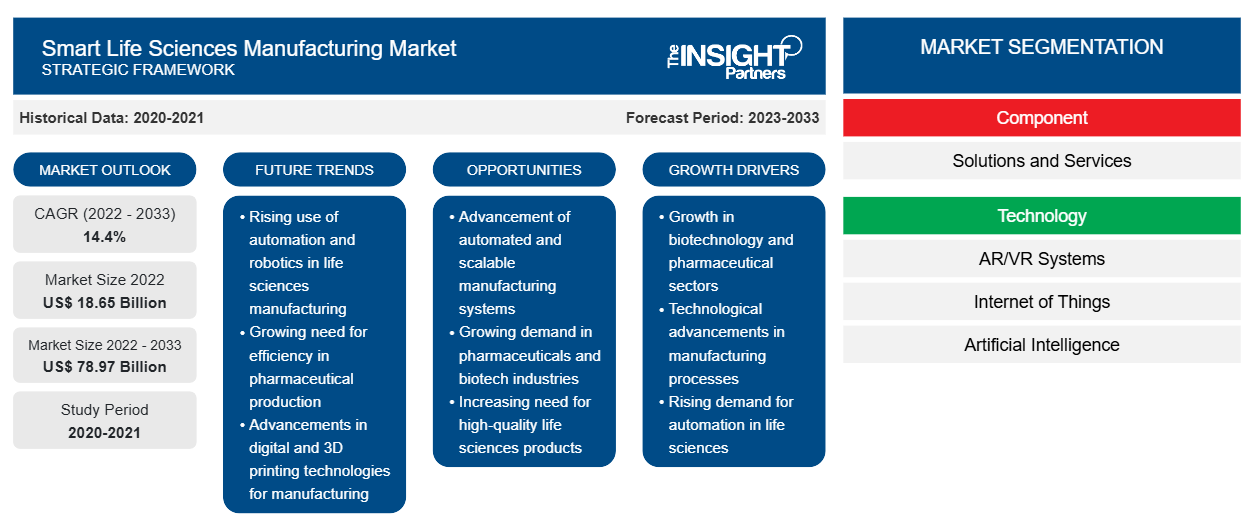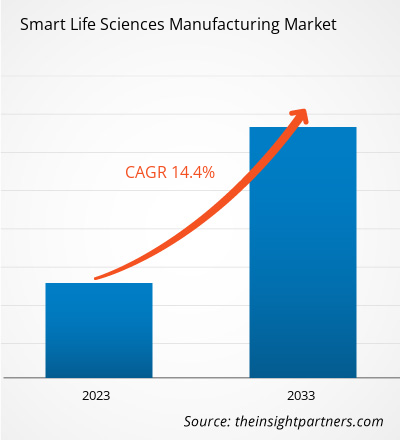Se proyecta que el mercado de fabricación de ciencias biológicas inteligentes alcance los 78.974,61 millones de dólares en 2033, desde los 18.649,50 millones de dólares en 2022; se espera que registre una CAGR del 14,4 % durante 2023-2033.
El proceso de fabricación de las ciencias de la vida ha cambiado significativamente en los últimos diez años. La fabricación de las ciencias de la vida es un proceso complejo. Un concepto de fábrica inteligente que interconecta la maquinaria y el sistema en el sitio de producción puede simplificar el proceso de fabricación. El sistema también está conectado con el cliente, el socio y el sitio de producción. Después de la pandemia de COVID-19, muchos fabricantes de productos farmacéuticos y dispositivos médicos comenzaron a adoptar la tecnología farmacéutica 4.0, especialmente debido al aumento de las regulaciones y las preocupaciones por la inspección. La fabricación inteligente de las ciencias de la vida, a menudo conocida como Pharma 4.0, tiene como objetivo proporcionar una guía práctica, integrar las mejores prácticas regulatorias y acelerar las transformaciones de Pharma 4.0. El objetivo principal es permitir que las organizaciones que participan en el ciclo de vida del producto farmacéutico controlen todo el potencial de la digitalización y brinden innovaciones terapéuticas más rápidas y procesos de producción mejorados para el beneficio de los usuarios finales. Estos cambios traerán enormes oportunidades a los fabricantes de ciencias de la vida en los próximos años. Las modernas herramientas de análisis de datos han permitido a los investigadores de biotecnología crear modelos de análisis predictivos y comprender las formas más efectivas de lograr sus metas y objetivos. Big data, IA, realidad virtual, visualización de datos y seguridad de datos se encuentran entre las tecnologías comunes que se utilizan en los laboratorios de biotecnología. Se espera que estos factores impulsen fuertemente el tamaño del mercado de fabricación de ciencias biológicas inteligentes en los próximos años.
Mercado de fabricación de ciencias biológicas inteligentes -
Personalice este informe según sus necesidades
Obtendrá personalización en cualquier informe, sin cargo, incluidas partes de este informe o análisis a nivel de país, paquete de datos de Excel, así como también grandes ofertas y descuentos para empresas emergentes y universidades.
- Obtenga las principales tendencias clave del mercado de este informe.Esta muestra GRATUITA incluirá análisis de datos, desde tendencias del mercado hasta estimaciones y pronósticos.
Perspectivas de mercado: mercado de fabricación inteligente de ciencias biológicas
El segmento farmacéutico es un contribuyente clave al sector industrial global. Además, la demanda y las ventas de medicamentos aumentan cada día. Por ello, las empresas de fabricación farmacéutica invierten enormes cantidades de recursos económicos en I+D para llevar innovaciones al mercado. Las actualizaciones tecnológicas son la clave para abordar los futuros problemas de fabricación. Con esto, el mercado Pharma 4.0 está ganando una gran atención en todo el mundo. En junio de 2022, GSK, una gran farmacéutica británica, inauguró su nueva planta de fabricación inteligente aséptica en Barnard Castle, Inglaterra. Esta planta totalmente automatizada aprovecha la digitalización para agilizar el proceso de fabricación. Esto, a su vez, permitiría a GSK acelerar el lanzamiento de nuevos medicamentos y reducir el desperdicio. En diciembre de 2020, Bayer AG anunció el lanzamiento de una plataforma de terapia celular y génica dentro de su división farmacéutica. Esta plataforma combinará múltiples funciones de columna vertebral para brindar soporte en toda la cadena de valor de la investigación y el desarrollo de terapias celulares y genéticas . En noviembre de 2020, el Reino Unido comenzó a construir una "fábrica del futuro" para renovar la producción de fármacos de moléculas pequeñas. Se espera que los fabricantes de medicamentos, las instituciones académicas, los proveedores de atención médica y los reguladores se reúnan en las instalaciones para probar y mejorar nuevas tecnologías, incluida la fabricación continua, digital y autónoma. Por lo tanto, se espera que la creciente adopción de la transformación digital impulse el tamaño del mercado de fabricación inteligente de ciencias biológicas.
Información basada en componentes
El mercado de fabricación inteligente de ciencias biológicas, por componente, se bifurca en soluciones y servicios. Se espera que el segmento de soluciones tenga una mayor participación en el mercado de fabricación inteligente de ciencias biológicas durante el período de pronóstico, a pesar de registrar tasas de crecimiento más lentas que el segmento de servicios. La industria farmacéutica está adoptando rápidamente la transformación digital a medida que la digitalización aporta flexibilidad y eficiencia a los procesos. Con la creciente complejidad de los sistemas y procesos de producción, establecer la interconectividad e implementar soluciones robustas de fábrica inteligente en línea con las buenas prácticas de fabricación (GMP) se han convertido en una prioridad estratégica para las empresas de ciencias biológicas. Además, la Industria 4.0 ha simplificado el proceso de acceso a los datos de las operaciones, además de permitir que las empresas cumplan con los indicadores clave de rendimiento (KPI) específicos. Las soluciones de fabricación inteligente ayudan en la gestión de la calidad al monitorear la temperatura y la humedad del inventario, monitorear la visibilidad del proceso de extremo a extremo, mejorar la consistencia del producto e identificar problemas específicos relacionados con la fabricación por lotes. La industria de las ciencias biológicas se dedica al desarrollo de tratamientos novedosos, efectivos, de calidad y precisos. Los pioneros de la industria están explorando nuevas áreas y enfoques terapéuticos aprovechando los últimos avances tecnológicos para obtener una ventaja competitiva. Estos factores impulsan el crecimiento del mercado de fabricación de ciencias biológicas inteligentes para el segmento de soluciones.
El mercado de fabricación de ciencias biológicas inteligentes está segmentado en función de los componentes, la tecnología y la aplicación. Según los componentes, el mercado se bifurca en soluciones y servicios. Por tecnología, el mercado de fabricación de ciencias biológicas inteligentes se segmenta en sistemas de realidad aumentada/realidad virtual (RA/RV), Internet de las cosas (IdC) , inteligencia artificial (IA), ciberseguridad, big data y otros. El segmento de IoT comandó la mayor participación de mercado de fabricación de ciencias biológicas inteligentes en 2022. Según la aplicación, el mercado de fabricación de ciencias biológicas inteligentes se segmenta en productos farmacéuticos, biofarmacéuticos y dispositivos médicos. Según la geografía, el mercado de fabricación de ciencias biológicas inteligentes se segmenta principalmente en América del Norte, Europa, Asia Pacífico (APAC), Oriente Medio y África (MEA) y América del Sur (SAM). ABB Ltd, Bosch Rexroth AG, Emerson Electric Co, Fortinet Inc, General Electric Co, Honeywell International Inc, IBM Corporation, Rockwell Automation, Siemens AG y Sophos Group plc se encuentran entre los actores clave del mercado de fabricación de ciencias biológicas inteligentes.
Perspectivas regionales del mercado de fabricación de ciencias biológicas inteligentes
Los analistas de Insight Partners explicaron en detalle las tendencias y los factores regionales que influyen en el mercado de fabricación de ciencias biológicas inteligentes durante el período de pronóstico. Esta sección también analiza los segmentos y la geografía del mercado de fabricación de ciencias biológicas inteligentes en América del Norte, Europa, Asia Pacífico, Oriente Medio y África, y América del Sur y Central.

- Obtenga datos regionales específicos para el mercado de fabricación de ciencias biológicas inteligentes
Alcance del informe del mercado de fabricación de ciencias biológicas inteligentes
| Atributo del informe | Detalles |
|---|---|
| Tamaño del mercado en 2022 | US$ 18,65 mil millones |
| Tamaño del mercado en 2033 | US$ 78,97 mil millones |
| CAGR global (2022-2033) | 14,4% |
| Datos históricos | 2020-2021 |
| Período de pronóstico | 2023-2033 |
| Segmentos cubiertos | Por componente
|
| Regiones y países cubiertos | América del norte
|
| Líderes del mercado y perfiles de empresas clave |
|
Densidad de actores del mercado de fabricación de ciencias biológicas inteligentes: comprensión de su impacto en la dinámica empresarial
El mercado de fabricación de productos de ciencias biológicas inteligentes está creciendo rápidamente, impulsado por la creciente demanda de los usuarios finales debido a factores como la evolución de las preferencias de los consumidores, los avances tecnológicos y una mayor conciencia de los beneficios del producto. A medida que aumenta la demanda, las empresas amplían sus ofertas, innovan para satisfacer las necesidades de los consumidores y aprovechan las tendencias emergentes, lo que impulsa aún más el crecimiento del mercado.
La densidad de actores del mercado se refiere a la distribución de las empresas o firmas que operan dentro de un mercado o industria en particular. Indica cuántos competidores (actores del mercado) están presentes en un espacio de mercado determinado en relación con su tamaño o valor total de mercado.
Las principales empresas que operan en el mercado de fabricación de ciencias biológicas inteligentes son:
- ABB Ltd
- Bosch Rexroth AG
- Compañía Eléctrica Emerson
- Fortinet Inc
- Compañía General Electric
Descargo de responsabilidad : Las empresas enumeradas anteriormente no están clasificadas en ningún orden particular.

- Obtenga una descripción general de los principales actores clave del mercado de fabricación de ciencias biológicas inteligentes
Los actores del mercado de fabricación de ciencias biológicas inteligentes se centran principalmente en las asociaciones para crear valor para el cliente.
- En febrero de 2023, Theragent, una CDMO de terapia celular centrada en el avance de tratamientos de próxima generación contra el cáncer y enfermedades raras, firmó un contrato exclusivo de varios años con Insight68, un proveedor de software impulsado por IA que tiene como objetivo digitalizar y agilizar el proceso de fabricación de terapias celulares. La asociación refuerza el compromiso de Theragent con el cumplimiento del registro de lotes 100 % digital y eleva la reputación de la empresa como CDMO líder en la actual transformación de la fabricación biofarmacéutica.
- En diciembre de 2022, Hovione anunció una colaboración estratégica con GEA para la fabricación de comprimidos continuos avanzados. Hovione es una empresa dedicada a industrializar y democratizar tecnologías farmacéuticas emergentes. Ofrece dispersiones sólidas amorfas secadas por aspersión convertidas en productos confiables y escalables, disponibles para todos.
- Análisis histórico (2 años), año base, pronóstico (7 años) con CAGR
- Análisis PEST y FODA
- Tamaño del mercado Valor/volumen: global, regional, nacional
- Industria y panorama competitivo
- Conjunto de datos de Excel



Report Coverage
Revenue forecast, Company Analysis, Industry landscape, Growth factors, and Trends

Segment Covered
This text is related
to segments covered.

Regional Scope
North America, Europe, Asia Pacific, Middle East & Africa, South & Central America

Country Scope
This text is related
to country scope.
Preguntas frecuentes
The incremental growth, expected to be recorded for the smart life sciences manufacturing market during the forecast period, is US$ 58,475.08 million.
The solutions segment led the smart life sciences manufacturing market with a significant share in 2022.
The smart life sciences manufacturing market is expected to reach US$ 78.974.61 million by 2033.
India, China, and Germany are expected to register high growth rates during the forecast period.
The US held the largest market share in 2022, followed by China.
Asia Pacific is the fastest growing regional market, followed by Europe.
The key players, holding majority shares, in smart life sciences manufacturing market includes ABB Ltd, Emerson Electric Co, General Electric Co, Honeywell International Inc, and Rockwell Automation.
The connection of data silos is increasing, which is likely to result in better access to insights and data leads. Additionally, there is an increasing usage of blockchain, coupled with roadmaps been created for Pharma 5.0.
Smart life sciences manufacturing market is being driven by the growing adoption of Pharma 4.0. Additionally, rising application of advanced technologies in cancer research is expected to provide growth opportunities for the smart life sciences manufacturing market.
The global smart life sciences manufacturing market was estimated to be US$ 18,649.50 million in 2022 and is expected to grow at a CAGR of 14.4%, during the forecast period 2023 - 2033.
Trends and growth analysis reports related to Technology, Media and Telecommunications : READ MORE..
The List of Companies - Smart Life Sciences Market
- ABB Ltd
- Bosch Rexroth AG
- Emerson Electric Co
- Fortinet Inc
- General Electric Co
- Honeywell International Inc
- IBM Corporation
- Rockwell Automation
- Siemens AG
- Sophos Group plc
The Insight Partners performs research in 4 major stages: Data Collection & Secondary Research, Primary Research, Data Analysis and Data Triangulation & Final Review.
- Data Collection and Secondary Research:
As a market research and consulting firm operating from a decade, we have published and advised several client across the globe. First step for any study will start with an assessment of currently available data and insights from existing reports. Further, historical and current market information is collected from Investor Presentations, Annual Reports, SEC Filings, etc., and other information related to company’s performance and market positioning are gathered from Paid Databases (Factiva, Hoovers, and Reuters) and various other publications available in public domain.
Several associations trade associates, technical forums, institutes, societies and organization are accessed to gain technical as well as market related insights through their publications such as research papers, blogs and press releases related to the studies are referred to get cues about the market. Further, white papers, journals, magazines, and other news articles published in last 3 years are scrutinized and analyzed to understand the current market trends.
- Primary Research:
The primarily interview analysis comprise of data obtained from industry participants interview and answers to survey questions gathered by in-house primary team.
For primary research, interviews are conducted with industry experts/CEOs/Marketing Managers/VPs/Subject Matter Experts from both demand and supply side to get a 360-degree view of the market. The primary team conducts several interviews based on the complexity of the markets to understand the various market trends and dynamics which makes research more credible and precise.
A typical research interview fulfils the following functions:
- Provides first-hand information on the market size, market trends, growth trends, competitive landscape, and outlook
- Validates and strengthens in-house secondary research findings
- Develops the analysis team’s expertise and market understanding
Primary research involves email interactions and telephone interviews for each market, category, segment, and sub-segment across geographies. The participants who typically take part in such a process include, but are not limited to:
- Industry participants: VPs, business development managers, market intelligence managers and national sales managers
- Outside experts: Valuation experts, research analysts and key opinion leaders specializing in the electronics and semiconductor industry.
Below is the breakup of our primary respondents by company, designation, and region:

Once we receive the confirmation from primary research sources or primary respondents, we finalize the base year market estimation and forecast the data as per the macroeconomic and microeconomic factors assessed during data collection.
- Data Analysis:
Once data is validated through both secondary as well as primary respondents, we finalize the market estimations by hypothesis formulation and factor analysis at regional and country level.
- Macro-Economic Factor Analysis:
We analyse macroeconomic indicators such the gross domestic product (GDP), increase in the demand for goods and services across industries, technological advancement, regional economic growth, governmental policies, the influence of COVID-19, PEST analysis, and other aspects. This analysis aids in setting benchmarks for various nations/regions and approximating market splits. Additionally, the general trend of the aforementioned components aid in determining the market's development possibilities.
- Country Level Data:
Various factors that are especially aligned to the country are taken into account to determine the market size for a certain area and country, including the presence of vendors, such as headquarters and offices, the country's GDP, demand patterns, and industry growth. To comprehend the market dynamics for the nation, a number of growth variables, inhibitors, application areas, and current market trends are researched. The aforementioned elements aid in determining the country's overall market's growth potential.
- Company Profile:
The “Table of Contents” is formulated by listing and analyzing more than 25 - 30 companies operating in the market ecosystem across geographies. However, we profile only 10 companies as a standard practice in our syndicate reports. These 10 companies comprise leading, emerging, and regional players. Nonetheless, our analysis is not restricted to the 10 listed companies, we also analyze other companies present in the market to develop a holistic view and understand the prevailing trends. The “Company Profiles” section in the report covers key facts, business description, products & services, financial information, SWOT analysis, and key developments. The financial information presented is extracted from the annual reports and official documents of the publicly listed companies. Upon collecting the information for the sections of respective companies, we verify them via various primary sources and then compile the data in respective company profiles. The company level information helps us in deriving the base number as well as in forecasting the market size.
- Developing Base Number:
Aggregation of sales statistics (2020-2022) and macro-economic factor, and other secondary and primary research insights are utilized to arrive at base number and related market shares for 2022. The data gaps are identified in this step and relevant market data is analyzed, collected from paid primary interviews or databases. On finalizing the base year market size, forecasts are developed on the basis of macro-economic, industry and market growth factors and company level analysis.
- Data Triangulation and Final Review:
The market findings and base year market size calculations are validated from supply as well as demand side. Demand side validations are based on macro-economic factor analysis and benchmarks for respective regions and countries. In case of supply side validations, revenues of major companies are estimated (in case not available) based on industry benchmark, approximate number of employees, product portfolio, and primary interviews revenues are gathered. Further revenue from target product/service segment is assessed to avoid overshooting of market statistics. In case of heavy deviations between supply and demand side values, all thes steps are repeated to achieve synchronization.
We follow an iterative model, wherein we share our research findings with Subject Matter Experts (SME’s) and Key Opinion Leaders (KOLs) until consensus view of the market is not formulated – this model negates any drastic deviation in the opinions of experts. Only validated and universally acceptable research findings are quoted in our reports.
We have important check points that we use to validate our research findings – which we call – data triangulation, where we validate the information, we generate from secondary sources with primary interviews and then we re-validate with our internal data bases and Subject matter experts. This comprehensive model enables us to deliver high quality, reliable data in shortest possible time.


 Obtenga una muestra gratuita de este informe
Obtenga una muestra gratuita de este informe